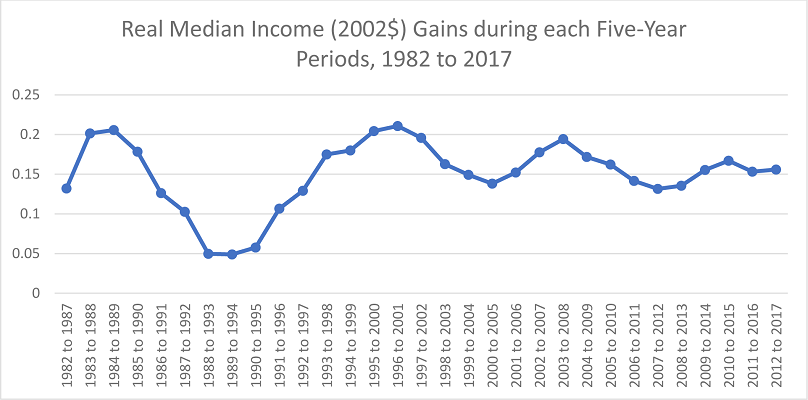Middle-class prosperity in Canada—some facts

After Prime Minister Trudeau introduced the men and women who will serve in his new cabinet, much attention has been dedicated to Mona Fortier, the new “minister for middle-class prosperity.”
To name a minister in charge of the prosperity of the middle class suggests that the middle class has had a tough time recently. This is only the latest iteration of a recurrent myth in Canadian politics peddled by members of all parties—that the middle class is stagnating.
But is it really? The main problem here is “defining” the middle is a complicated task. Fortier herself actually claimed to use a loose definition of the term. Some like to use the average income of the middle 20 per cent of the population (when ranked by income). Others use a certain absolute income threshold. However, the most often-used measure (even if there are debates over it) is the median income—the income of the person in the middle of the population that cuts the remaining population into two equal shares.
By that measure, there appears to be very small improvements since the mid-1970s. However, this is misleading.
Impressions of stagnation of the median are mathematical illusions caused by changing demographics, which create a situation where, when comparing different income statistics from year-to-year, you compare apples with oranges and then apples with bananas. These situations are known as “composition biases.”
Consider the following thought experiment. A group of 50 Canadians, all with incomes that go from $100 to $5,000, experience a 10 per cent increase in income. Accordingly, all statistics should go up 10 per cent—the median, the average income for the middle 20 per cent, the average for everyone. However, if an extra 10 people with incomes of $100 enter the group, then all of these statistics will fall, despite the fact that everyone else gained 10 per cent extra income. This is because a key factor is not held equal between the two points—the composition of the population.
Is there a similar process at play in Canada? Yes! Take the example of immigration.
When immigrants enter a given country (while they often enjoy massive income gains relative to incomes in their countries of origin), their incomes tend to be inferior to the native population. The addition of immigrants is thus equivalent to the example above. But as long as the immigrant population remains steady, there’s no creeping composition bias. From the 1950s to the mid-1980s, the share of foreign-born Canadians remained steady at around 7 per cent. However, starting in the mid-1980s, the share began to increase and exceeded the 10 per cent mark. This means immigrants are dragging down the distribution. It does not mean that people were becoming poorer.
The same applies to other demographic changes. For example, an aging population will cause the same effect. Older people tend to have lower earnings because they are consuming their savings. Because seniors are growing more numerous in Canada, the median income will be pushed down even if no one experiences a decline in living standards.
Both examples illustrate the problem caused by changes in demographic composition, which may cause some people to make false judgments about the living standards of certain populations. The best way to see this is to track the same people over time. The type of data needed to provide this portrait is known as “longitudinal data.” By tracking the same individuals over time, longitudinal data circumvent composition bias, where the apples of 1985 are compared with oranges from 2019. We simply evaluate how the apples of 1985 fare later on.
Statistics Canada has such data, which track individuals over five-year periods between 1982 and 2017. What happened to the median income for the same people over each five-year period? With the exception of 1988 to 1996, the real median market income of the same people tracked over each five-year period increased by around 15 per cent (see chart below).

If you track people over a longer period of time, the gains are even clearer. The main limitation with the Statistics Canada data mentioned above is that they’re subsequent sets of longitudinal groups over five years. This is a relatively short period of time, which could lead skeptics to shrug at the evidence above.
However, the Fraser Institute produced a study that covered the years from 1993 and 2019. The 20 per cent of the population in the middle of the income distribution in 1993 had—by 2012—enjoyed real income gains of 70 per cent (and this is a conservative estimate of the gains because only wages and salaries are included—adding other sources of income will only add to these gains). Moreover, that study also finds that the poorest 20 per cent of the population enjoyed income gains equal to 781 per cent. This means that many of the poorest of 1993 had propelled themselves into the middle class (and above) by 2012.
Do such gains indicate stagnation? Clearly not. Rather, everything indicates that the middle class in Canada is doing better. Could things have improved at a faster pace? Obviously. However, it’s better not to peddle inaccurate depictions of the situation when constructing public policy. Let’s hope our new federal minister for middle-class prosperity keeps this in mind.
Author:
Subscribe to the Fraser Institute
Get the latest news from the Fraser Institute on the latest research studies, news and events.

